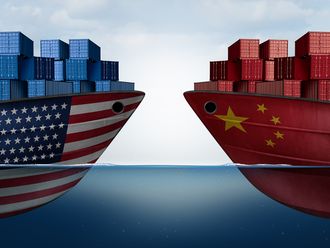Inflation or deflation? A V-shaped recovery or something indistinguishable from recession? Enough new hiring to reduce unemployment or another jobless recovery?
Predicting the future is always dicey, no matter how hard economic modellers try to convince you otherwise. Getting a grasp on the here and now is generally easier.
Not this time. Rarely have so many observers looked at the US economy and come to such diametrically opposed conclusions. We're either entering the Promised Land or staring into an abyss.
Even the business cycle gurus at the National Bureau of Economic Research came up short when they convened on April 8. Members of the Business Cycle Dating Committee (BCDC) met, talked and decided any determination of a cyclical trough to the recession that started in December 2007 would be "premature".
The index of coincident economic indicators, a monthly proxy for the measures the BCDC tracks, bottomed in June. Real gross domestic product turned positive in the third quarter of last year. Most economists think the recession ended in June or July 2009.
How can we explain the bipolar views? One way is to differentiate between a cyclical upswing — the result of easy money and massive government spending — and sustainable growth.
Recent economic indicators, with the exception of housing, have been upbeat. Manufacturing is humming, and consumers are spending even though confidence indexes remain at recessionary levels. Washington's enthusiasm over the 123,000 private non- farm jobs created in March hasn't filtered down to the public psyche.
Worsening finances
Consumers say their personal financial condition is worsening rather than improving by a ratio of two to one, according to the preliminary Reuters/University of Michigan Index of Consumer Sentiment Index for April. Respondents don't expect much of a gain in real income, jeopardising strong spending.
The inflation-deflation dichotomy may be easier to explain. A Wall Street Journal survey of 57 economists conducted last week found the group split, 50-50, on whether accelerating or decelerating inflation was the greater concern over the next 12 months.
The increase in core inflation, which excludes food and energy, has slowed to about a 1 per cent year-over-year pace from a peak of 2.9 per cent in 2006. Disinflation could turn to deflation, leaving the Federal Reserve no way out with the benchmark rate close to zero, according to many economists.
An overwhelming 87 per cent of economists surveyed by the Journal said they are more concerned about inflation over the next five years. If inflation expectations are the be-all and end-all of policy, this kind of endorsement from a jury of the Fed's peers should be a red flag.
One group sees inflation hiding under every rock and behind the $1.1 trillion (Dh4 trillion) of excess reserves. The explosion in the Fed's balance sheet to a record $2.34 trillion last week is more than enough tinder for inflation.
The broadest measure of money, or M2, isn't growing at all. With banks sitting on excess reserves and the Fed determined to prevent an inflation outbreak, a brief bout of deflation is possible.
Leading economic indicators are pointing up. Economists expect the economy grew 3 per cent in the first quarter, according to a Bloomberg News survey. That's not exactly the kind of rubber-band effect that follows long, deep recessions, but it's nothing to sneeze at.
Unconvincing growth
Yet this recovery is all chemical additives. Benchmark interest rates have been at zero to 0.25 basis points for 16 months and are likely to remain there "for an extended period", according to the Fed.
It may be costless for banks to borrow, but holding rates at zero won't be costless for the Fed or the economy. Extended periods of negative real interest rates don't end well.
The same goes for fiscal policy. Massive government spending may show up in today's GDP, but it will be at the expense of private investment tomorrow.
Fed policymakers have made it clear they believe a still- fragile economy needs low interest rates to nurse it back to health.
Using low interest rates to stabilise housing is apt to destabilise some other sector of the economy or sow the seeds of future inflation.
Of course, the Fed has yet to concede the housing bubble was in any way, shape or form the result of its ultra-low interest rates from 2003 to 2005. This seems absurd, and it is. If policymakers can't understand how we got here, no wonder the rest of us are lost when it comes to figuring out where we are.












